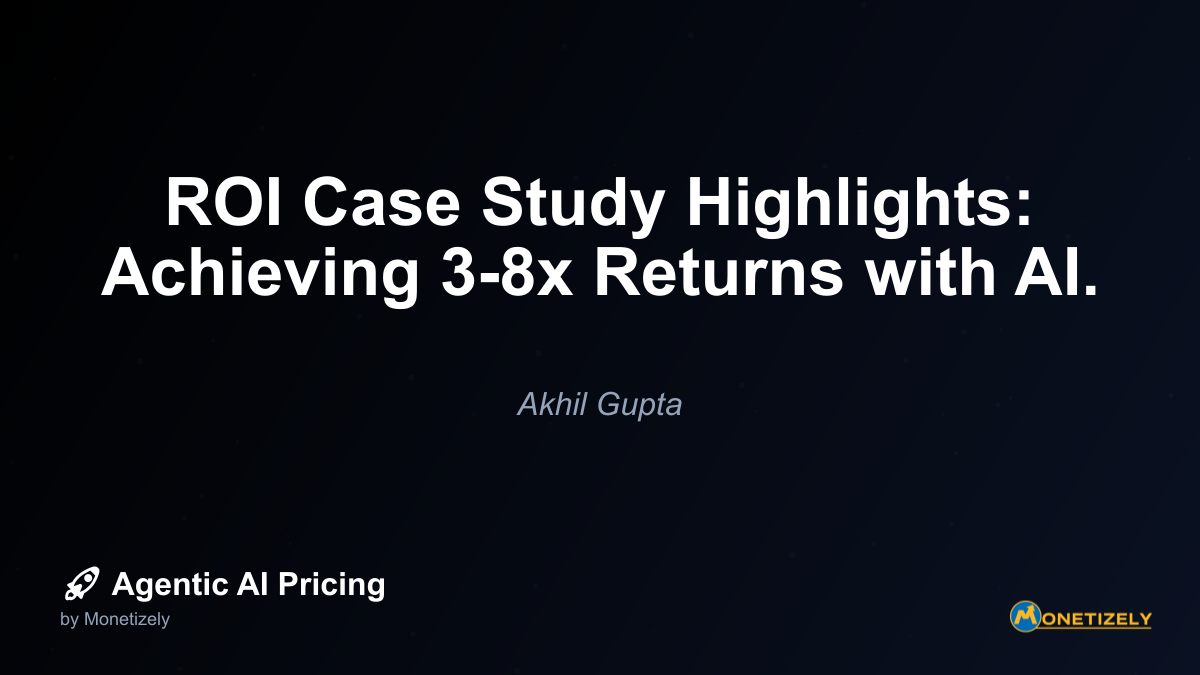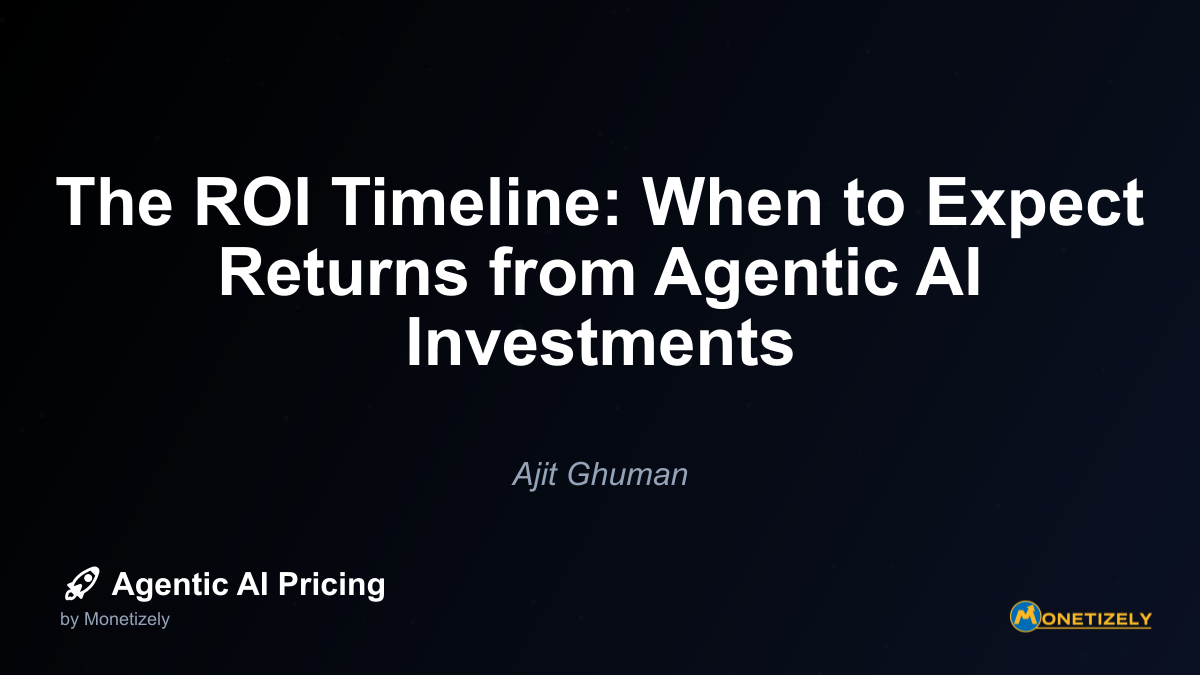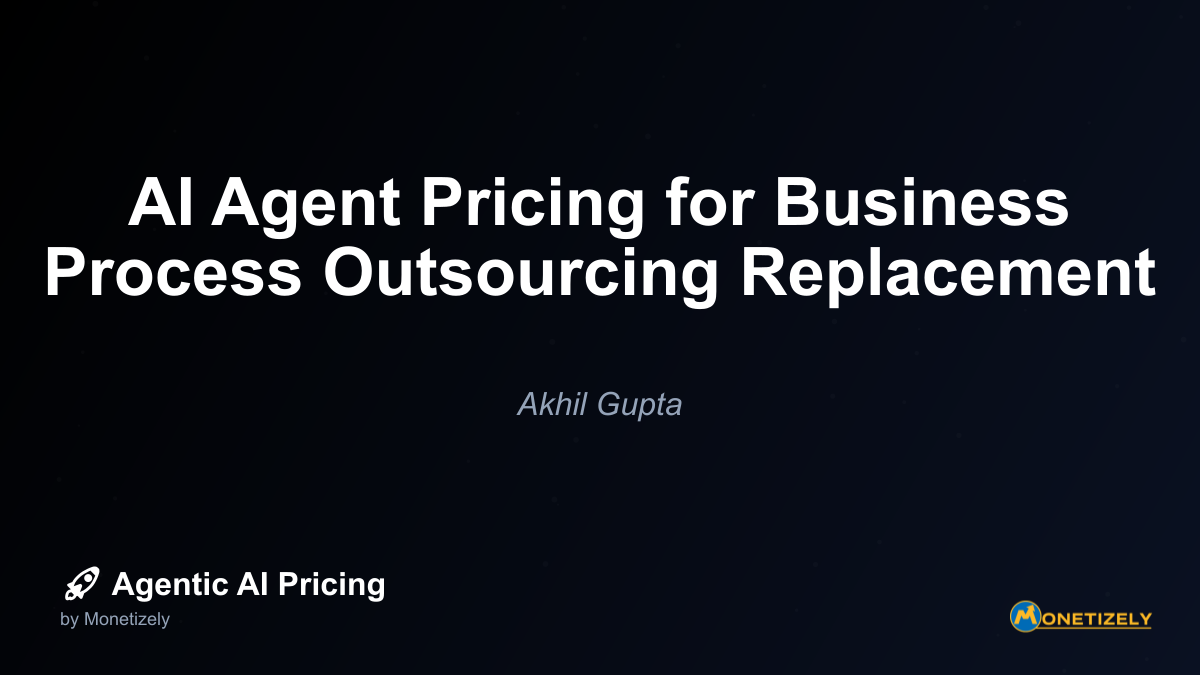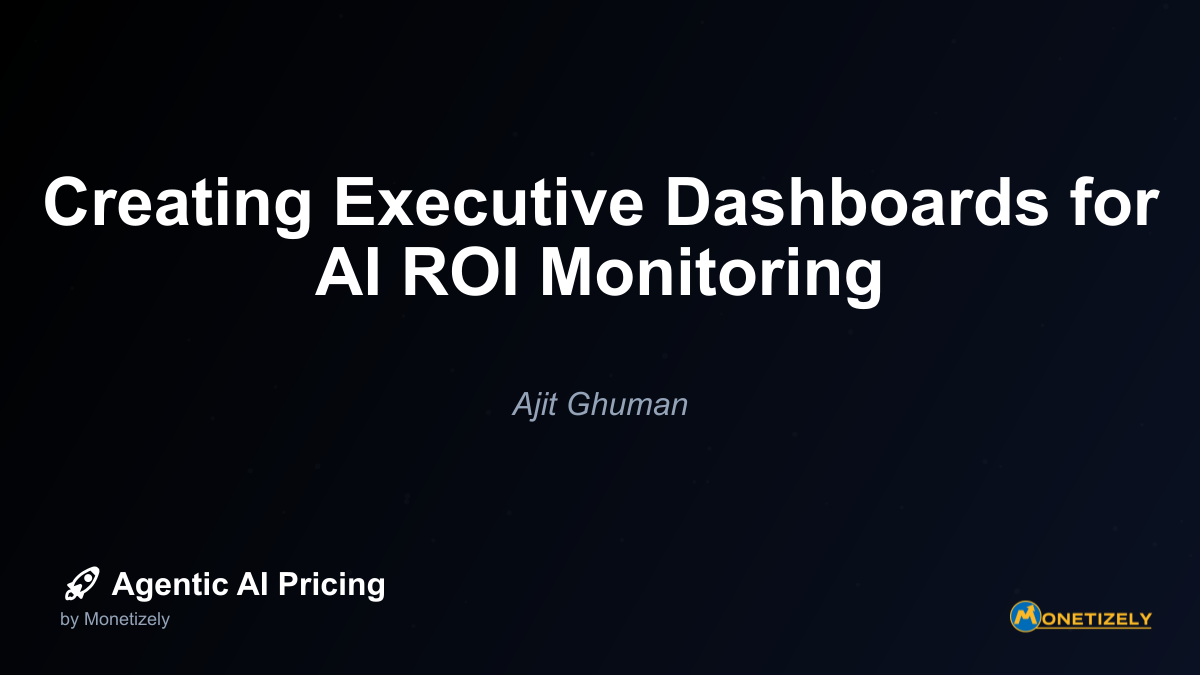· Ajit Ghuman · ROI and Value · 11 min read
Measuring ROI for Agentic AI Projects (Formula & Approach).
AI and SaaS Pricing Masterclass
Learn the art of strategic pricing directly from industry experts. Our comprehensive course provides frameworks and methodologies for optimizing your pricing strategy in the evolving AI landscape. Earn a professional certification that can be imported directly to your LinkedIn profile.
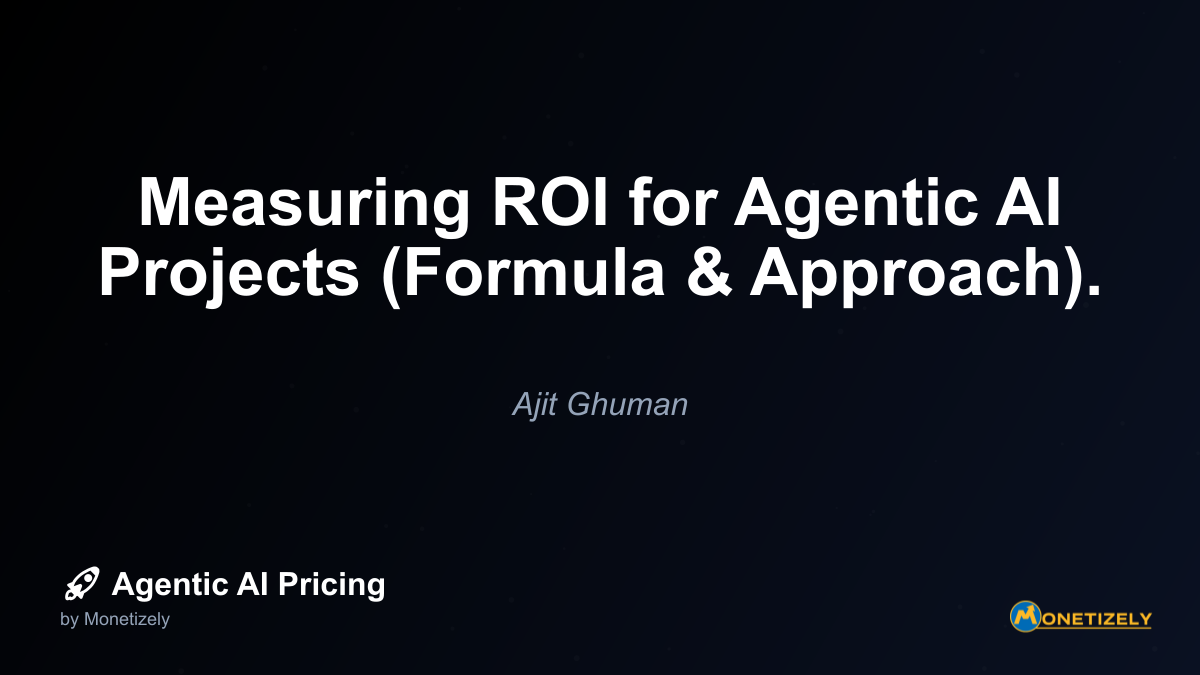
In today’s data-driven business environment, measuring the return on investment (ROI) for agentic AI initiatives has become a critical capability for organizations seeking to justify, optimize, and scale their AI investments. While traditional ROI calculations provide a starting point, the unique characteristics of agentic AI—autonomous decision-making, continuous learning, and multi-faceted impact across organizations—require a more sophisticated and nuanced approach to measurement.
Understanding the Fundamentals of Agentic AI ROI
At its core, ROI for agentic AI follows the classic formula: net benefits divided by total costs, expressed as a percentage. However, the autonomous and evolving nature of agentic systems demands a more comprehensive framework that captures both immediate and long-term value creation.
The basic formula for calculating ROI is:
ROI = ((Net Benefits from AI - Total Cost of AI Investment) / Total Cost of AI Investment) × 100%For agentic AI specifically, this formula needs to be expanded to account for multiple dimensions of value:
ROI = ((Revenue Gains + Cost Savings + Productivity Improvements + Risk Mitigation Value) - (Implementation Costs + Operational Costs + Training Costs + Maintenance Costs)) / Total Investment × 100%According to recent industry research, organizations implementing agentic AI can expect ROI multiples ranging from 3.7x to 4x on average, with high-performing implementations reaching up to 10x return on investment.
Comprehensive Cost Components for Agentic AI Projects
To accurately measure ROI, you must first identify and quantify all relevant costs associated with your agentic AI initiative. These costs typically fall into several categories:
1. Initial Investment and Implementation Costs
- Software and Platform Licensing: Costs for AI platforms, frameworks, and specialized tools
- Hardware Infrastructure: Dedicated servers, GPUs, cloud computing resources
- Development and Integration: Custom AI agent development, API integration, embedding with internal systems
- Initial Training: Model training, fine-tuning, and dataset preparation
Development costs can vary significantly based on complexity and scope, typically ranging from $30,000 to $300,000+ for initial development, plus API setup fees.
2. Ongoing Operational Costs
- API Usage Fees: Recurring costs for large language model API calls ($1,000-$5,000+/month)
- Cloud and Infrastructure: Storage, computing, and vector database costs ($500-$2,500/month)
- Monitoring and Maintenance: Cloud monitoring, AI observability platforms ($200-$1,000/month)
- Personnel: AI engineers, prompt engineers, MLOps teams, and support staff
- Continuous Training: Model updates, retraining, and performance optimization
3. Hidden and Indirect Costs
- Change Management: Training employees, process redesign, and organizational adaptation
- Downtime and Error Correction: Cost of system failures or incorrect outputs
- Compliance and Risk Management: Legal reviews, audits, and risk mitigation measures
- Technical Debt: Future costs from system limitations or outdated architecture
- Opportunity Costs: Value lost from delays or inefficient implementation
The comprehensive accounting of these costs provides the denominator for your ROI calculation and helps establish realistic expectations for investment returns.
Identifying and Measuring Agentic AI Benefits
The numerator in the ROI equation—the benefits derived from agentic AI—encompasses a range of tangible and intangible returns that organizations should systematically track and measure.
Tangible Benefits
1. Cost Reduction and Efficiency Gains
- Labor Cost Savings: Reduced headcount or reallocation of staff to higher-value activities
- Process Efficiency: Faster completion of tasks, reduced cycle times
- Error Reduction: Fewer mistakes requiring correction or rework
- Resource Optimization: Better utilization of assets and resources
These savings can be substantial. For example, AES Energy implemented agentic AI for automated safety audits, resulting in cost savings exceeding $1 million annually and a 90% reduction in audit time.
2. Revenue Enhancement
- Increased Sales: Higher conversion rates, cross-selling, or upselling
- New Revenue Streams: AI-enabled products or services
- Faster Time-to-Market: Accelerated product development and deployment
- Customer Retention: Improved loyalty and reduced churn
Retail sector implementations of agentic AI for personalized shopping experiences have demonstrated revenue increases of 20-35%, according to recent case studies.
3. Productivity Improvements
- Time Savings: Reduction in hours spent on routine or manual tasks
- Increased Output: Higher volume of work completed in the same timeframe
- Faster Decision-Making: Reduced latency in analysis and action
- Scalability: Ability to handle increased workload without proportional cost increases
C3IT, an Indian IT consultancy, achieved 30% faster document creation and 60% reduction in kick-off presentation preparation time through agentic AI implementation.
Intangible Benefits
1. Enhanced Customer Experience
- Improved Satisfaction: Higher CSAT or Net Promoter Scores
- Personalization: More relevant and tailored interactions
- 24/7 Availability: Continuous service without interruption
- Consistency: Standardized quality of interaction
2. Employee Experience Improvements
- Reduced Burnout: Elimination of repetitive, low-value tasks
- Higher Engagement: Focus on more meaningful work
- Skill Development: Opportunity to learn and apply new capabilities
- Workplace Satisfaction: Improved morale and retention
3. Strategic Advantages
- Better Decision Quality: More data-informed and timely decisions
- Risk Reduction: Proactive identification and mitigation of issues
- Organizational Agility: Faster response to market changes
- Innovation Acceleration: New capabilities and business models
Practical ROI Calculation Framework for Agentic AI
To implement a structured approach to measuring ROI for your agentic AI projects, follow this step-by-step framework:
Step 1: Establish Clear Objectives and Baseline Metrics
Before implementing agentic AI, define specific business goals and document current performance metrics to serve as a baseline for comparison. These might include:
- Current process cycle times
- Labor costs for specific functions
- Error rates and quality metrics
- Customer satisfaction scores
- Revenue per customer or transaction
- Time spent on specific tasks
Step 2: Develop a Comprehensive Cost Model
Create a detailed cost inventory that captures all aspects of your agentic AI investment:
Total Cost = Implementation Costs + Operational Costs + Indirect Costs
Where:
- Implementation Costs = Software + Hardware + Development + Integration + Initial Training
- Operational Costs = API Fees + Infrastructure + Maintenance + Personnel + Continuous Training
- Indirect Costs = Change Management + Risk Management + Technical DebtEnsure your cost model accounts for both one-time investments and recurring expenses over the expected lifecycle of the AI system.
Step 3: Track and Measure Benefits
Implement systems to track both tangible and intangible benefits:
For Tangible Benefits:
Cost Savings = (Baseline Costs - Post-Implementation Costs)
Revenue Gains = (Post-Implementation Revenue - Baseline Revenue)
Productivity Improvements = (Value of Time Saved + Value of Additional Output)For Intangible Benefits:
- Use proxy metrics (e.g., customer retention as a proxy for satisfaction)
- Implement surveys and feedback mechanisms
- Assign estimated financial values to qualitative improvements
Step 4: Calculate Time-Adjusted ROI
Since agentic AI benefits often compound over time as the system learns and improves, calculate ROI across multiple time horizons:
Short-term ROI (3-6 months):
Short-term ROI = (Initial Benefits - Initial Costs) / Initial Costs × 100%Medium-term ROI (6-18 months):
Medium-term ROI = (Cumulative Benefits - Total Costs to Date) / Total Costs to Date × 100%Long-term ROI (18+ months):
Long-term ROI = NPV(Future Benefits) - NPV(Future Costs) / NPV(Total Investment) × 100%Using Net Present Value (NPV) calculations for long-term ROI provides a more accurate picture by accounting for the time value of money.
Step 5: Implement Continuous Monitoring and Optimization
Establish a dashboard to track ROI metrics in real-time and identify opportunities for optimization:
- Monitor KPIs against targets
- Analyze performance trends
- Identify bottlenecks or underperforming areas
- Implement improvements and measure impact
Real-World Case Studies: Measuring Agentic AI ROI in Practice
Examining successful implementations provides valuable insights into effective ROI measurement approaches.
Bank of America - Erica Virtual Assistant
Bank of America’s agentic AI assistant, Erica, serves over 10 million users monthly. The bank’s comprehensive ROI measurement approach tracked:
- Cost Reduction: 30% decrease in operational expenses through call center load reduction
- Revenue Impact: 25% increase in revenue through personalized recommendations and streamlined services
- Customer Experience: Improved satisfaction metrics and engagement rates
- Strategic Value: Enhanced competitive positioning in digital banking
By combining these dimensions into a holistic ROI framework, Bank of America demonstrated the multi-faceted value of their agentic AI investment beyond simple cost savings.
AES Energy - Automated Safety Audits
AES Energy implemented agentic AI for safety audits, with ROI measured across several key dimensions:
- Direct Cost Savings: Over $1 million annually in reduced audit expenses
- Efficiency Gains: 90% reduction in audit completion time
- Risk Mitigation: Improved compliance and reduced safety incidents
- Personnel Reallocation: Safety professionals redirected to higher-value activities
This case illustrates how ROI measurement should incorporate both immediate financial returns and broader operational and strategic benefits.
Crediclub - AI-Powered Auditing
Financial services provider Crediclub deployed agentic AI for auditing functions and measured ROI through:
- Cost Efficiency: 96% monthly savings on auditing expenses
- Accuracy Improvement: Reduced error rates in compliance monitoring
- Scalability: Ability to handle increased transaction volume without proportional cost increases
- Risk Reduction: Earlier detection of potential compliance issues
Their approach demonstrates how industry-specific metrics can enhance ROI measurement for specialized applications of agentic AI.
Common Challenges in Measuring Agentic AI ROI
Despite the clear framework outlined above, organizations often encounter several challenges when measuring ROI for agentic AI projects:
1. Attribution Complexity
Isolating the specific impact of AI from other concurrent initiatives or market changes can be difficult. This challenge is particularly acute when AI is deployed alongside other digital transformation efforts.
Solution: Implement robust tracking and logging systems that tag actions and outcomes attributable to AI agents. Consider controlled experiments or A/B testing where feasible to isolate AI’s contribution.
2. Learning Curve and Training Time
Agentic AI systems typically improve over time through reinforcement learning and continuous optimization. Initial performance may not reflect the system’s full potential, leading to underestimated ROI.
Solution: Measure ROI across multiple time horizons and account for the expected learning curve in your projections. Document performance improvements over time to demonstrate the compounding value of AI investments.
3. Misaligned Expectations
Stakeholders may expect immediate results from agentic AI, leading to premature judgments about ROI before the system has fully matured or been optimized.
Solution: Set realistic expectations by communicating the typical adoption curve for agentic AI. Establish incremental milestones and celebrate early wins while emphasizing the long-term value proposition.
4. Intangible Benefit Quantification
Many valuable benefits of agentic AI—such as improved decision quality, enhanced customer experience, or reduced risk—are inherently difficult to quantify in financial terms.
Solution: Develop proxy metrics and estimation methods for intangible benefits. For example, customer satisfaction improvements can be linked to retention rates and lifetime value calculations.
5. Cultural Resistance
Employee resistance to AI adoption can undermine realized benefits and distort ROI measurements if not properly addressed.
Solution: Include change management effectiveness in your ROI framework. Track adoption rates, user satisfaction, and feedback to ensure the human side of implementation is supporting rather than hindering value realization.
Advanced ROI Framework for Agentic AI Projects
Building on the fundamentals, an advanced ROI framework for agentic AI should incorporate the following elements:
Multi-Dimensional Value Assessment
Rather than a single ROI percentage, create a balanced scorecard that tracks value across multiple dimensions:
| Value Dimension | Sample Metrics | Measurement Approach |
|---|---|---|
| Financial Impact | Cost reduction, revenue growth | Direct financial tracking |
| Operational Efficiency | Process speed, throughput, error rates | Before/after comparisons |
| Customer Value | Satisfaction scores, retention rates | Surveys, behavioral analytics |
| Employee Impact | Productivity, satisfaction, retention | Time tracking, surveys |
| Strategic Advantage | Market share, innovation rate | Competitive analysis |
| Risk Management | Compliance incidents, security breaches | Incident tracking |
Time-Phased ROI Calculation
Recognize that agentic AI value typically follows a curve:
- Investment Phase (0-6 months): Negative ROI as costs exceed early benefits
- Value Acceleration (6-18 months): Rapidly improving ROI as benefits scale and costs stabilize
- Sustained Value (18+ months): High positive ROI as the system reaches maturity and delivers compounding benefits
Calculate and report ROI separately for each phase to provide a more accurate picture of the investment trajectory.
Continuous Improvement Integration
Link ROI measurement directly to your improvement cycle:
- Measure current performance and ROI
- Analyze gaps between actual and potential value
- Optimize the AI system to address identified gaps
- Re-measure to quantify improvement impact
This closed-loop approach ensures that ROI measurement drives ongoing value enhancement rather than serving merely as a retrospective assessment.
Future Trends in Agentic AI ROI Measurement
As agentic AI continues to evolve, ROI measurement approaches are also advancing. Key emerging trends include:
1. Multi-Modal, Contextual Performance Metrics
As agentic AI expands to include multi-modal interactions (text, audio, video, images) and more sophisticated causal reasoning, ROI frameworks will need to incorporate metrics that assess effectiveness across these dimensions. This includes measuring AI’s performance in complex decision-making scenarios, collaborative problem-solving, and adaptability to changing workflows.
2. Dynamic and Self-Adaptive Measurement
The self-adapting nature of advanced agentic AI will be mirrored in ROI tracking systems that continuously adjust benchmarks and KPIs to reflect the AI’s changing capabilities and impact. This represents a shift from static pre/post comparisons to real-time, feedback-driven evaluations.
3. Industry-Specific ROI Frameworks
Specialized ROI frameworks tailored to specific industries will emerge, incorporating metrics like:
- Healthcare: Clinical accuracy, patient outcomes, treatment optimization
- Financial Services: Regulatory compliance, risk reduction, fraud prevention
- Manufacturing: Quality improvements, equipment utilization, supply chain optimization
- Retail: Personalization effectiveness, inventory optimization, customer lifetime value
4. Ethical and Responsible AI Metrics
As regulatory scrutiny increases, ROI frameworks will expand to include metrics related to:
- Algorithmic fairness and bias mitigation
- Transparency and explainability
- Privacy protection and data governance
- Environmental impact (e.g., carbon footprint of AI operations)
These dimensions will become increasingly important in comprehensive ROI assessments as organizations face both regulatory requirements and stakeholder expectations for responsible AI deployment.
Best Practices for Implementing an Agentic AI ROI Framework
To maximize the effectiveness of your ROI measurement approach, consider these best practices:
1. Start with Business Objectives
Anchor your ROI framework to specific business problems and objectives rather than technology capabilities. This ensures measurement focuses on outcomes that matter to stakeholders.
2. Establish Governance and Accountability
Assign clear ownership for ROI tracking and reporting, with executive sponsorship to ensure visibility and action on insights.
3. Implement Iterative Deployment
Start with pilot projects focused on high-impact areas to validate ROI before scaling. This approach reduces risk and provides early validation of your measurement framework.
4. Maintain Human Oversight
Include human-in-the-loop mechanisms during initial deployment phases to validate AI performance and avoid costly errors that could negatively impact ROI.
5. Communicate Regularly
Share ROI metrics and insights with stakeholders on a regular cadence, highlighting both successes and opportunities for improvement. This transparency builds trust and supports continued investment.
6. Refine Continuously
Treat your ROI framework as a living system that evolves as your understanding of agentic AI’s impact deepens and as new measurement approaches become available.
ROI Calculation Examples for Common Agentic AI Use Cases
Customer Service AI Agent
Costs:
- Implementation: $150,000 (development, integration, training)
- Annual Operation: $60,000 (API fees, maintenance, monitoring)
Benefits:
- Labor Savings: $200,000 annually (reduction in customer service headcount)
- Improved Resolution: $75,000 annually (faster issue resolution, fewer escalations)
Co-Founder & CEO
Ajit is the author of Price To Scale, a top book on SaaS Pricing and is the Founder of Monetizely. Ajit has led and worked in pricing and product marketing at firms like Twilio, Narvar and Medallia. His work has been featured in Forbes and VentureBeat. Ajit regularly consults with software companies from Seed stage to post-IPO on pricing strategy. Ajit is also a highly-rated co-instructor for 'The Art of SaaS Pricing and Monetization' on Maven.
Pricing Strategy Audit
Let our experts analyze your current pricing strategy and identify opportunities for improvement. Our data-driven assessment will help you unlock untapped revenue potential and optimize your AI pricing approach.

